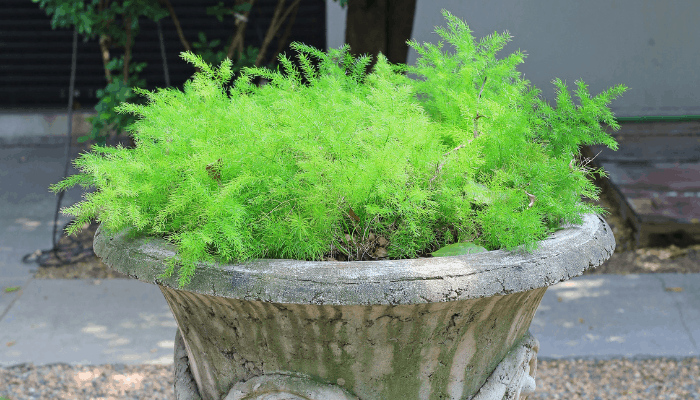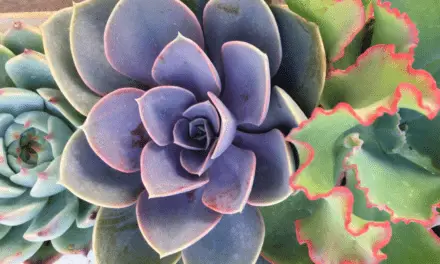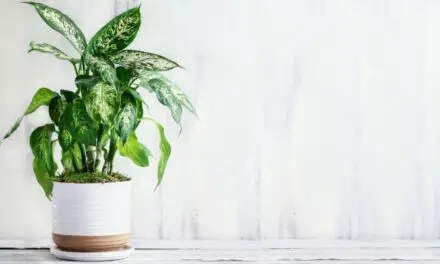The asparagus fern is a hardy plant that can tolerate low light conditions and won’t wither up when kept indoors where there may be limited fresh air.
This uncommon houseplant is not a real fern but it’s a relative of the lily and the vegetable we know as Asparagus.
The asparagus fern’s light, feathery foliage makes it an attractive plant to grow indoors or around the house.
Table of Contents
The Best Potting Soil for Asparagus Ferns
If you plan to grow an Asparagus Fern indoors, you’re going to want to make sure the potting soil is dry and nutrient-rich with excellent drainage. Keeping the soil loose and uncompacted is essential or they may drown.
How Do You Care For An Asparagus Fern?

To make the best potting soil for your asparagus fern effective, you’ll need to know the basics about how to look after your plant.
How Much Light Does An Asparagus Fern Need?
Asparagus ferns like bright, indirect sunlight.
The best spots in the home for indirect light can be found in locations with an east-facing window.
Bright interior rooms that receive full light from large west-facing or south-facing windows can also suit your asparagus fern.
How Much Water Does My Asparagus Fern Need?
Keep your asparagus fern well-watered, but use a pot with drainage holes so it doesn’t sit in water.
It is a thirsty plant so you may need to water it more often than other plants you’re used to looking after.
Test the top two inches of soil with your finger and if it is completely dry then give the soil a good watering until it’s moist.
Best Temperature For Your Asparagus Fern
Normal household temperatures that are a little on the warmer side work well.
Should I Mist My Asparagus Fern?
Asparagus ferns like humidity so when growing them indoors you can mist them daily with a focus on their arching stems.
Does My Asparagus Fern Need Fertilizer?
You can feed your asparagus fern with all-purpose plant food that is liquid or water-soluble and diluted to 1/2 strength.
During the summer months, your plant may need to be fed weekly feedings but otherwise just feed your asparagus fern monthly.
They are relatively low maintenance, so you don’t have to fawn after them like you would Oriental lilies.
Asparagus Fern Botanical Facts
These botanical members of the Lily family are a cousin to asparagus, but asparagus ferns are not edible and very poisonous.
Their name comes from their growth appearing like little spears of Asparagus.
Stalks and leaves develop from a rhizome buried underground into above-ground tubers.
They may grow as a clump or a mound and sprawl or trail.
Some species even appear denser and look like a foxtail, with distinct and separate leaf stalks.
Asparagus Fern Is Not A Fern
Unlike most ferns, an asparagus fern doesn’t have fronds and can produce flowers and berries.
Birds love these berries but they are not safe for human consumption, causing abdominal pain, vomiting, and diarrhea.
They usually aren’t affected by disease or insects like other lilies and ferns, which is what makes them easier to grow than many other plants from the lily family.
Where Do Asparagus Ferns Come From?
Because they come from South Africa, asparagus ferns enjoy an arid environment.
They are very hardy and sometimes considered an invasive outdoor weed that can crowd and choke native plants.
Best Potting Medium For Asparagus Ferns
Asparagus ferns can take any standard potting medium for houseplants.
You can make the potting soil loamier if you wish, but don’t use fine sand.
It’s preferable that you incorporate small rocks, stones, and pebbles into the soil with a pot containing many drainage holes on the bottom.
They love being in pots. In fact, they become much more dense and thick growing that way.
But you will have to divide the stalks about every two to three years.
This is because the mass of tubers will crowd the pot.
Crowding creates suffocation, thereby preventing proper plant drainage.
Watering And Fertilizing Tips
It may be a good idea to mist the soil rather than pour water right onto it.
This will ensure the plant gets enough moisture while not drowning at the same time.
Do not give the plant any amount of water if the soil is even the slightest bit moist.
Water them sparingly and fertilize monthly with a weak mixture.
Dappled Shade or Full Sun
Asparagus ferns grow best in dappled shade but they can tolerate some full sun and are fairly drought resistant.
When you put them in a spot with lots of shade, allow them to trail over edges, ledges, and balconies.
When grown in full sun, they are more compact and bushier than trailing or sprawling.
Climate And Weather Considerations
If you’re growing an asparagus fern in a pot, and you don’t live in a hardy zone between 9 and 11, you will have to do some work to provide it the conditions it loves.
You can keep an asparagus fern outdoors in the summer but you may want to bring it inside for the winter.
They cannot tolerate any amount of frost or extreme cold.
Asparagus ferns experience a stage of rest or hibernation and don’t grow much throughout the winter, where they require even less water than they do in the summer.
Make sure they get indirect sunlight and keep their general environmental temperature between 55°F and 70°F.
Final Thoughts
The asparagus fern isn’t what you’d call a common houseplant, but it makes for quite an attractive houseplant with its light and feathery foliage.
Taking great care of and using the best potting soil for your asparagus fern will help to keep your plant thick, bushy and in great health for years to come.




